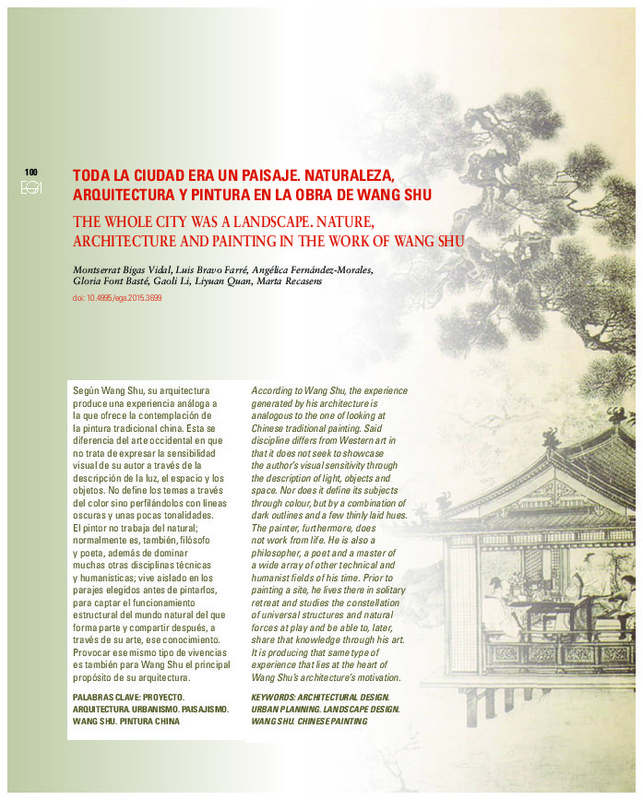JavaScript is disabled for your browser. Some features of this site may not work without it.
Buscar en RiuNet
Listar
Mi cuenta
Estadísticas
Ayuda RiuNet
Admin. UPV
Toda la ciudad era un Paisaje. Naturaleza, arquitectura y pintura en la obra de Wang Shu
Mostrar el registro sencillo del ítem
Ficheros en el ítem
| dc.contributor.author | Bigas Vidal, Montserrat
|
es_ES |
| dc.contributor.author | Bravo Farré, Luis
|
es_ES |
| dc.contributor.author | Fernández-Morales, Angélica
|
es_ES |
| dc.contributor.author | Font Baste, Gloria
|
es_ES |
| dc.contributor.author | Li, Gaoli
|
es_ES |
| dc.contributor.author | Quan, Liyuan
|
es_ES |
| dc.contributor.author | Recasens, Marta
|
es_ES |
| dc.date.accessioned | 2017-01-03T12:44:57Z | |
| dc.date.available | 2017-01-03T12:44:57Z | |
| dc.date.issued | 2015-06-22 | |
| dc.identifier.issn | 1133-6137 | |
| dc.identifier.uri | http://hdl.handle.net/10251/76251 | |
| dc.description.abstract | [EN] According to Wang Shu, the experience generated by his architecture is analogous to the one of looking at Chinese traditional painting. Said discipline differs from Western art in that it does not seek to showcase the author’s visual sensitivity through the description of light, objects and space. Nor does it define its subjects through colour, but by a combination of dark outlines and a few thinly laid hues. The painter, furthermore, does not work from life. He is also a philosopher, a poet and a master of a wide array of other technical and humanist fields of his time. Prior to painting a site, he lives there in solitary retreat and studies the constellation of universal structures and natural forces at play and be able to, later, share that knowledge through his art.It is producing that same type of experience that lies at the heart of Wang Shu’s architecture’s motivation | es_ES |
| dc.description.abstract | [ES] Según Wang Shu, su arquitectura produce una experiencia análoga a la que ofrece la contemplación de la pintura tradicional china. Esta se diferencia del arte occidental en que no trata de expresar la sensibilidad visual de su autor a través de la descripción de la luz, el espacio y los objetos. No define los temas a través del color sino perfilándolos con líneas oscuras y unas pocas tonalidades. El pintor no trabaja del natural; normalmente es, también, filósofo y poeta, además de dominar muchas otras disciplinas técnicas y humanísticas; vive aislado en los parajes elegidos antes de pintarlos, para captar el funcionamiento estructural del mundo natural del que forma parte y compartir después, a través de su arte, ese conocimiento. Provocar ese mismo tipo de vivencias es también para Wang Shu el principal propósito de su arquitectura | es_ES |
| dc.language | Español | es_ES |
| dc.language | Inglés | es_ES |
| dc.publisher | Universitat Politècnica de València | |
| dc.relation.ispartof | EGA. Revista de Expresión Gráfica Arquitectónica | |
| dc.rights | Reserva de todos los derechos | es_ES |
| dc.subject | Chinese painting | es_ES |
| dc.subject | Wang Shu | es_ES |
| dc.subject | Architectural design | es_ES |
| dc.subject | Urban planning | es_ES |
| dc.subject | Pintura China | es_ES |
| dc.subject | Urbanismo | es_ES |
| dc.subject | Paisajismo | es_ES |
| dc.title | Toda la ciudad era un Paisaje. Naturaleza, arquitectura y pintura en la obra de Wang Shu | es_ES |
| dc.title.alternative | The whole city was a landscape. Nature, architecture and painting in the work of Wang Shu | es_ES |
| dc.type | Artículo | es_ES |
| dc.date.updated | 2017-01-03T11:22:05Z | |
| dc.identifier.doi | 10.4995/ega.2015.3699 | |
| dc.rights.accessRights | Abierto | es_ES |
| dc.description.bibliographicCitation | Bigas Vidal, M.; Bravo Farré, L.; Fernández-Morales, A.; Font Baste, G.; Li, G.; Quan, L.; Recasens, M. (2015). Toda la ciudad era un Paisaje. Naturaleza, arquitectura y pintura en la obra de Wang Shu. EGA. Revista de Expresión Gráfica Arquitectónica. 20(25):100-107. https://doi.org/10.4995/ega.2015.3699 | es_ES |
| dc.description.accrualMethod | SWORD | es_ES |
| dc.relation.publisherversion | https://doi.org/10.4995/ega.2015.3699 | es_ES |
| dc.description.upvformatpinicio | 100 | es_ES |
| dc.description.upvformatpfin | 107 | es_ES |
| dc.type.version | info:eu-repo/semantics/publishedVersion | es_ES |
| dc.description.volume | 20 | |
| dc.description.issue | 25 | |
| dc.identifier.eissn | 2254-6103 |








